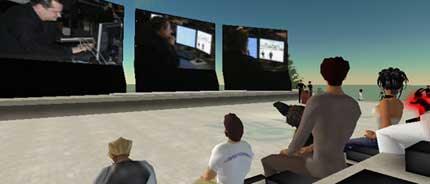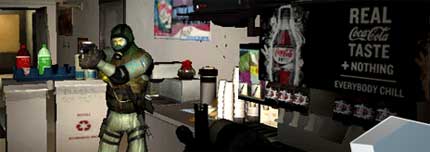clickable culture informs of an article in Harvard business review about Avatars-based marketing.
The strong involvement of Second Life (and other virtual worlds)’s residents with their virtual environment (from personalized avatars to virtual businesses, scheduled celebrity book signings, etc.) constitutes a dream marketing venue. Commerce is already an integral part of the game. Residents spend—in Linden dollars—the equivalent of $5 million a month on transactions for in-world products and services. Introducing real-world brands is just a logical step.
Whom do marketing efforts target? The members who gave their credit card numbers to register for the game—or their avatars? If the real-world human controls the real-world wallet, the avatar represents a different “shadow” consumer, one able to influence its creator’s purchase of real-world products and conceivably make its own real-world purchases in the virtual world.
The real-world marketing potential of online worlds is suggested by the virtual commerce that already takes place within them. In Second Life, you find avatar-run businesses such as virtual clothing and real estate brokering, but also detective agencies, which keep an eye on virtual infidelity; a notary public, who guarantees the legitimacy of avatar contracts; sex shops, which sell not only racy paraphernalia but also computer code that allows two avatars to enter into a passionate embrace, etc.
 Lessig in Second Life
Lessig in Second Life
The line between virtual and real worlds is blurring in other ways. In Second Life, the BBC recently broadcast a segment of its Newsnight program from within the world. Lawrence Lessig gave a speech to a full house and signed virtual copies of his latest book. A proliferation of “Impeach Bush” signs—that were installed by an avatar on tiny plots of land he had purchased, blocking many people’s views—created an uproar.
Furthermore, many residents import real-world company logos as props or decorations. Coke machines are common. Evian was advertised at the concession stand of a recent U2 tribute concert. An iPod store sells virtual players loaded with tunes audible when your avatar wears one of the devices.
The combination of virtual-world commerce and the growing overlap of virtual worlds and the real world suggests opportunities for creative real-world marketers. So far, there have been a few interesting brand-building experiments. In the Sims Online, McDonald’s installed fast-food kiosks, complete with employees working at the counter and able to serve up (free) burgers and fries to residents who made their selections from a clickable menu. Intel incorporated its logo into the screens of virtual computers that, when purchased by Sims Online residents, helped them improve their game skills. In There, Levi Strauss promoted a new style of jeans by offering virtual versions for sale to avatars, pricing them at a premium to the generic virtual jeans that avatars otherwise could purchase. Nike sold virtual shoes that allowed wearers to run faster than other avatars.
 Habbo Hotel
Habbo Hotel
Organizations have also sponsored branded events in virtual worlds. Kellogg’s sponsored a competition, in Habbo Hotel, in which residents were asked to decorate their personal rooms in various Pop-Tart–related themes. In a noncommercial sponsorship, the American Cancer Society staged its Relay for Life event in Second Life. Resident avatars walked a virtual course, lighted virtual luminaries, and raised virtual cash, which was converted into more than $5,000 in real cash and donated to the organization.
Companies have also created entirely branded virtual worlds—”adverworlds.” Wells Fargo bank recently launched Stagecoach Island to educate teens about money matters through games and social activities. In a similar vein, DaimlerChrysler has a site for preteens called Mokitown to educate players—called “mokis,” short for mobile kids—about road and traffic safety through a shared social experience.
 Mokitown
Mokitown
Patrice Varni says the 2003 campaign in which residents of There outfitted themselves in Levi’s virtual jeans was an interesting experiment but one she had hoped would yield more data. Technology is improving, though, and she can envision placements in which users could, by making an in-world purchase of an appealing style of jeans, effect a real-world online purchase.
In the meantime, there may be little to lose from experimenting. Massive Incorporated, which sells real-world advertising in a network of computer games, recently signed a deal to place ads in the online virtual world Entropia Universe. In Second Life, marketers can simply become residents and have their avatars try out marketing initiatives for free—something a number of companies are already doing, according to David Fleck, from Linden Lab. “People think they need to create a partnership with us, but all they have to do is join, go and buy a chunk of land, and then do what they want to do,� says Fleck.
 Screenshot from Massive Incorporated website
Screenshot from Massive Incorporated website
For starters, avatars are certainly useful subjects for market research. “Marketing depends on soliciting people’s dreams,â€? says Henry Jenkins. “And here those dreams are on overt display.” For instance, a company could track how inhabitants of a virtual world interact with a particular type of product, noting choices they make about product features, wardrobe mix, or even virtual vacation destinations. It could then use those choices to create profiles of potential customer segments.
UPDATE: One Second Life denizen has created three ad spots to stimulate demand for the Nylon 35mm, the Nyloid Super Color 1000, and the Nylonic VHS Camcorder. (more in unmediated)
